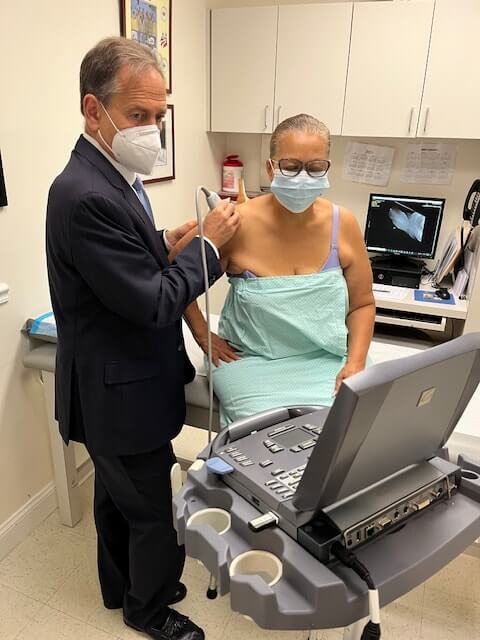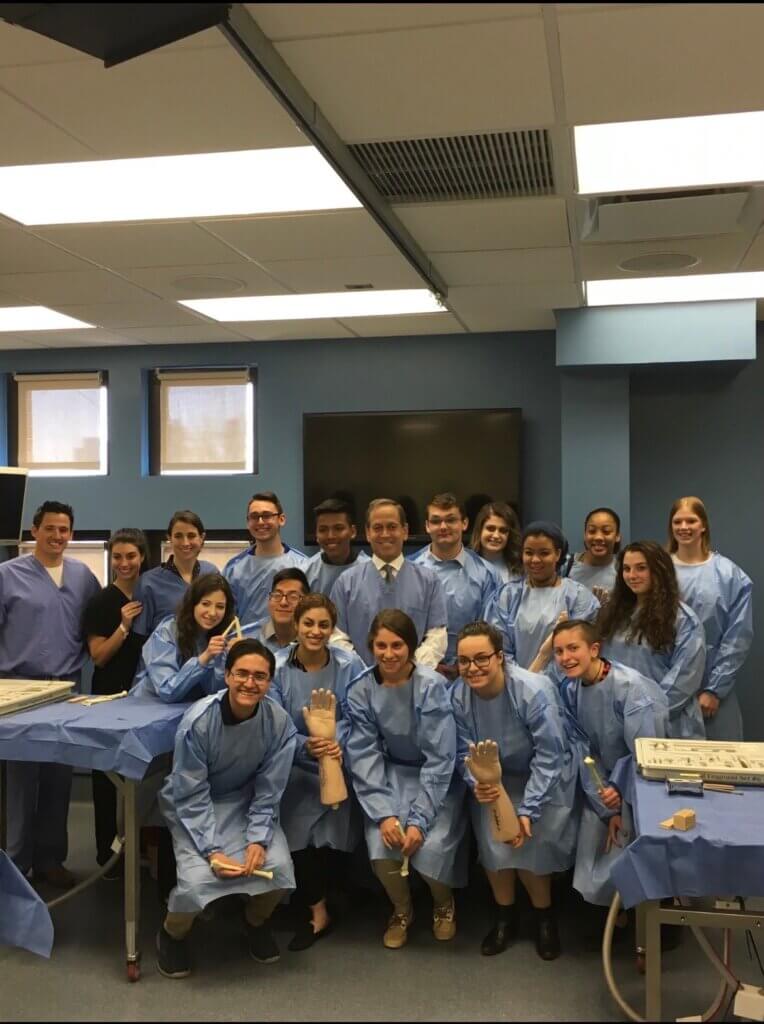Shoulder Pain Treatments
Shoulder pain is a common issue that can stem from a variety of injuries or underlying medical conditions. Let’s explore the causes, symptoms, and treatment options available for shoulder pain, providing you with a comprehensive guide to better understand and manage discomfort. At Plancher Orthopaedics & Sports Medicine, we specialize in diagnosing and treating shoulder injuries, offering advanced, personalized care to help patients find relief and regain mobility. Whether your pain is due to overuse, trauma, or an underlying condition, identifying the source is crucial for effective treatment and long-term recovery.
Key Takeaways
- Shoulder pain is a common issue influenced by its complex anatomy, with rotator cuff injuries being among the most frequent causes.
- Effective treatment options range from non-surgical methods like physical therapy and medication to surgical interventions like arthroscopy for severe injuries.
- Plancher Orthopaedics offers advanced diagnostic and treatment techniques while prioritizing personalized care for patients with shoulder injuries.

Understanding Shoulder Pain
Shoulder pain is one of the most common orthopedic problems that individuals face today. The shoulder is a complex and highly mobile joint, making it susceptible to a variety of issues. The instability of the shoulder joint arises from its wide range of motion; the ball and socket joint of the upper arm bone is larger than the socket of the shoulder, which provides its vast mobility but also makes it prone to shoulder dislocation and shoulder joint bone spurs.
The rotator cuff, a group of muscles and tendons surrounding the shoulder joint, plays a critical role in maintaining the stability of this joint. These muscles and tendons allow for a wide range of motion, but they are also prone to injuries such as rotator cuff tears, a torn rotator cuff, and rotator cuff tendinitis. When these structures are compromised, it can lead to severe pain and reduced mobility.
Shoulder pain can be localized to the shoulder area or radiate to surrounding regions, sometimes even extending down the arm. This pain can arise from various factors, including issues in the neck, which can cause referred pain in the shoulder. Knowledge of shoulder anatomy and mechanics helps in pinpointing and treating the causes of shoulder pain.
Common Causes of Shoulder Pain
There are numerous causes of shoulder pain, with rotator cuff injuries being among the most prevalent. A rotator cuff tear can result from overuse, aging, or acute injuries like a fall. Tendinosis, which involves the wearing out of the rotator cuff tendons, often leads to inflammation and pain due to the tendons being pinched under bone structures in the shoulder.
Another common cause is shoulder impingement, where the rotator cuff rubs against the shoulder blade, causing pain and inflammation. This condition, known as impingement syndrome, can lead to severe pain, especially when you lift your arm above the head. Impingement symptoms include aching pain in the top and outer shoulder, weakness in the arm, and difficulty sleeping due to discomfort.
Frozen shoulder, or adhesive capsulitis, is another condition that restricts motion due to inflammation and adhesions. Bursitis, the inflammation of the bursa, can also cause significant discomfort in the shoulder joint. These conditions, along with arthritis and shoulder dislocations, contribute to the various causes of shoulder pain.
Identifying Symptoms
Recognizing shoulder pain symptoms is key to accurate diagnosis and treatment. Pain often appears on the outer side and under the acromion, worsening with arm movements, especially overhead lifting. Discomfort can vary from mild to severe, significantly affecting daily activities.
Sudden left shoulder pain might signal a heart attack and requires immediate medical attention. Additionally, shoulder pain at night can be aggravated by lying on the affected shoulder, disrupting sleep.
Referred pain, where the discomfort originates from other areas such as the neck or lungs, can also manifest as shoulder pain. Awareness of these symptoms aids in identifying the cause and directing appropriate treatment.
Diagnosing Shoulder Pain
A thorough physical assessment and specific tests are essential to diagnose the root cause of shoulder pain. The process starts with observing the shoulder and its range of motion to identify swelling, bruising, or deformities.
A cervical spine examination is essential to rule out any contributing spinal issues before focusing solely on the shoulder. Various tests are performed during the shoulder exam to confirm or eliminate specific injuries, including tests for shoulder instability, which check for symptoms like the shoulder feeling as if it is ‘giving way’. These evaluations diagnose conditions like rotator cuff injuries, shoulder impingement, and biceps tendinopathy.
Imaging tests like X-rays, MRIs, or ultrasounds become crucial if physical exams suggest serious injuries or potential surgery. These imaging techniques provide detailed views of the shoulder’s internal structures, helping to pinpoint the exact cause of the pain and plan the most effective treatment strategy.
Risk Factors for Shoulder Pain
Several risk factors can increase the likelihood of developing shoulder pain. Poor shoulder posture is a significant risk factor, as it can lead to abnormal shoulder movement and subsequent tears in the muscles and tendons. Repetitive overhead activities, common in certain occupational roles such as construction or painting, also elevate the risk of shoulder pain.
Athletes who engage in sports involving overhead motions, like volleyball or swimming, are particularly prone to shoulder injuries. Age is another factor, with the likelihood of developing shoulder pain increasing as one gets older. Recognizing these risk factors aids in preventing and managing shoulder pain effectively.
Treatment Options for Shoulder Pain
Treating shoulder pain involves a range of options, from non-surgical treatments to surgical interventions. Non-surgical treatments often include medications, from over-the-counter to prescription anti-inflammatory drugs, aimed at reducing inflammation and providing pain relief. Cortisone injections can also be administered directly into the shoulder joint to alleviate inflammation and pain effectively.
If non-surgical treatments prove ineffective, surgical options may be required. Options include minimally invasive procedures like arthroscopy and more extensive surgeries such as rotator cuff repair. Treatment choice depends on the condition’s severity and the patient’s overall health.
Non-Surgical Treatments
Non-surgical treatments for shoulder pain are often the first line of defense and can be very effective. Here are some methods to consider:
- Cooling the affected area can help manage acute shoulder pain by reducing inflammation.
- Taking nonsteroidal anti-inflammatory drugs (NSAIDs) can provide pain relief.
- Avoiding activities that exacerbate the pain, such as lifting the affected arm over the head, is crucial during the acute phase.
Physical therapy is crucial in non-surgical treatment, emphasizing shoulder strengthening and improved range of motion. Passive exercises with a physical therapist improve shoulder movement and aid recovery. Rehabilitation programs tailored for athletes, such as those in New Canaan, address their specific needs related to shoulder injuries.
Practicing physical therapy exercises at home maintains and enhances shoulder mobility and strength. Self-care measures, like rotator cuff exercises, significantly aid in managing and relieving shoulder pain.
Surgical Interventions
Surgical intervention may be needed for severe shoulder conditions when non-surgical treatments fall short. Minimally invasive procedures like arthroscopy use small incisions and cameras, leading to faster recovery and less post-operative pain. Plancher Orthopaedics employs these advanced techniques to ensure effective treatment with minimal downtime.
Rotator cuff repair surgery addresses severe damage when non-surgical methods fail. Plancher Orthopaedics emphasizes expertise in treating shoulder injuries with these advanced surgical techniques, ensuring comprehensive care for their patients.
Home Care Tips for Managing Shoulder Pain
Managing shoulder pain at home involves several practical strategies. Moist heat alleviates pain by loosening the shoulder, enhancing mobility. Using an ice pack for 20 minutes multiple times daily reduces swelling and offers significant pain relief.
Adjusting activities to minimize pain and prevent re-injury is another key strategy. This includes avoiding carrying heavy bags on one shoulder and keeping frequently used items within easy reach to limit unnecessary shoulder strain.
Proper sitting posture and avoiding overhead activities are vital during recovery. These effective home care tips help manage and reduce shoulder pain, promoting quicker and more comfortable recovery.

Advanced Diagnostics and Treatment at Plancher Orthopaedics
Plancher Orthopaedics uses modern diagnostic tools and treatments for various orthopedic conditions, including shoulder injuries. The clinic employs cutting-edge robotic surgery and regenerative therapies to enhance recovery from shoulder injuries. Advanced techniques ensure precise diagnosis and effective treatment tailored to each patient.
Dr. Kevin D. Plancher leads a multidisciplinary team that collaborates in creating personalized treatment plans, ensuring comprehensive care. Combining advanced diagnostics, personalized treatments, and specialized care ensures a holistic approach to shoulder injury management. The clinic’s commitment to positive patient experiences is evident in their supportive and engaging approach throughout the healthcare journey.
Plancher Orthopaedics offers specialized shoulder injury care in Greenwich, New Canaan, Westport, Upper East Side, and Upper West Side, using advanced arthroscopic techniques for minimal downtime. Their combination of advanced medical expertise and compassionate care empowers patients in their health decisions.
Demographics and Shoulder Injury Demand in Key Locations
Demand for specialized orthopedic care varies by location and is influenced by local demographics and lifestyles. Connecticut’s active communities frequently experience shoulder injuries from sports and recreational activities, while New York’s diverse population, including active professionals and retirees, often prefers minimally invasive treatments for quicker recovery.
Connecticut
Connecticut’s active communities, engaged in both youth and adult recreational sports, commonly face shoulder injuries such as rotator cuff tears, labral tears, impingement, and arthritis. Dr. Kevin Plancher’s orthopedic expertise ensures effective diagnosis, treatment, and customized rehabilitation for these conditions, helping residents maintain their active lifestyles with a focus on swift recovery.
New York
In New York, residents include a mix of active professionals, retirees, and sports enthusiasts who value less invasive treatments to minimize recovery time. High demand for outpatient and minimally invasive procedures meets the needs of those wanting to quickly resume their daily activities. Clinics like Plancher Orthopaedics address these injury patterns with personalized care strategies, ensuring comprehensive treatment and rehabilitation across age groups.
Personalized Patient Care at Plancher Orthopaedics
Personalized patient care is a top priority at Plancher Orthopaedics. The practice provides a welcoming environment with a luxurious waiting area for comfort and relaxation. Patients enjoy direct access to the care team, enhancing communication and reducing wait times for a more efficient healthcare experience.
Plancher Orthopaedics offers customized rehabilitation programs for athletes and active adults, particularly in New Canaan and the Upper West Side. These tailored programs promote quick and effective recovery, addressing specific needs and activities. This holistic approach to wellness features personalized consultations and continuous support, ensuring optimal care throughout recovery.
Combining advanced medical expertise with compassionate care, the practice empowers patients to make informed health decisions. This blend of cutting-edge techniques and patient-focused care distinguishes Plancher Orthopaedics as a leader in orthopedic treatment and rehabilitation.

Contact Plancher Orthopaedics
Understanding and managing shoulder pain requires a comprehensive approach, including recognizing symptoms, identifying risk factors, and exploring various treatment options. Plancher Orthopaedics & Sports Medicine stands out for its advanced diagnostics, personalized care, and commitment to patient well-being. Whether through non-surgical treatments, home care, or surgical interventions, effective strategies for shoulder pain relief are available to help you regain your quality of life. Contact Plancher Orthopaedics & Sports Medicine today to schedule a consultation and take the first step toward long-lasting relief and recovery.
Frequently Asked Questions
What are the most common causes of shoulder pain?
Shoulder pain is often caused by rotator cuff tears, impingement syndrome, bursitis, arthritis, and frozen shoulder, typically resulting from overuse, injuries, or inflammation. Identifying these underlying issues is crucial for effective treatment and relief.
How is shoulder pain diagnosed?
Shoulder pain is diagnosed through a comprehensive physical examination, targeted tests to determine the nature of the injury, and imaging studies like X-rays or MRIs to visualize the shoulder’s internal structures. This method ensures accurate identification of the issue.
What non-surgical treatments are available for shoulder pain?
Non-surgical treatments for shoulder pain include NSAIDs, physical therapy, cortisone injections, and modifying activities to alleviate pain and inflammation. These approaches can effectively manage symptoms without the need for surgery.
When is surgery necessary for shoulder pain?
Surgery is necessary for shoulder pain when non-surgical treatments do not relieve symptoms, often leading to options like arthroscopy or rotator cuff repair depending on the severity of the issue. It is essential to consult with a healthcare professional for an accurate assessment.
How can I manage shoulder pain at home?
To effectively manage shoulder pain at home, apply moist heat or ice packs, modify activities to prevent strain, maintain proper posture, and perform strengthening exercises. These strategies can significantly alleviate discomfort and promote recovery.

 Joseph M. Ajdinovich, M.D.
Joseph M. Ajdinovich, M.D. Jeffrey T. Alwine, D.O.
Jeffrey T. Alwine, D.O. Shariff K. Bishai, M.S., D.O.
Shariff K. Bishai, M.S., D.O. Peter B. Blank, D.O.
Peter B. Blank, D.O. David B. Dickerson, M.D.
David B. Dickerson, M.D. Albert S.M. Dunn, D.O.
Albert S.M. Dunn, D.O. Eric D. Fornari MD
Eric D. Fornari MD Monet A. France, M.D.
Monet A. France, M.D. Mary Ann Gardner, M.D., Lieutenant Commander, Medical Corp, USNR
Mary Ann Gardner, M.D., Lieutenant Commander, Medical Corp, USNR Michael J. Kaplan, MD
Michael J. Kaplan, MD Harish Kempegowda, M.D.
Harish Kempegowda, M.D.  Bradley J. Lawson, M.D.
Bradley J. Lawson, M.D. Sheryl L. Lipnick, D.O.
Sheryl L. Lipnick, D.O. Timothy A. Luke, M.D.
Timothy A. Luke, M.D. Marc J. Philippon, MD
Marc J. Philippon, MD Pedro A. Piza, M.D.
Pedro A. Piza, M.D. Kevin D. Plancher, MD, MPH
Kevin D. Plancher, MD, MPH Alberto R. Rivera-Rosado, M.D.
Alberto R. Rivera-Rosado, M.D. William I. Sterett, MD
William I. Sterett, MD William W. Stewart, M.D.
William W. Stewart, M.D. Francesca M. Swartz, D.O.
Francesca M. Swartz, D.O. Seth R. Miller, MD
Seth R. Miller, MD Paul M. Sethi, MD
Paul M. Sethi, MD  William D. Murrell, MD
William D. Murrell, MD Tyler J. Brolin MD
Tyler J. Brolin MD Thomas B. Evely, DO
Thomas B. Evely, DO Clifford Voigt, MD
Clifford Voigt, MD Karthikeyan Chinnakkannu, MD
Karthikeyan Chinnakkannu, MD Erik Carlson, MD
Erik Carlson, MD Marc S. Kowalsky, MD
Marc S. Kowalsky, MD  Rachel M. Frank, MD
Rachel M. Frank, MD Max N. Seiter, MD
Max N. Seiter, MD Demetris Delos, MD
Demetris Delos, MD Armando F. Vidal, MD
Armando F. Vidal, MD Lauren M. Fabian, MD
Lauren M. Fabian, MD R. Tim Greene, MD
R. Tim Greene, MD Peter J. Millett, MD, MSc
Peter J. Millett, MD, MSc Jaya Shanmugam, M.D.
Jaya Shanmugam, M.D.